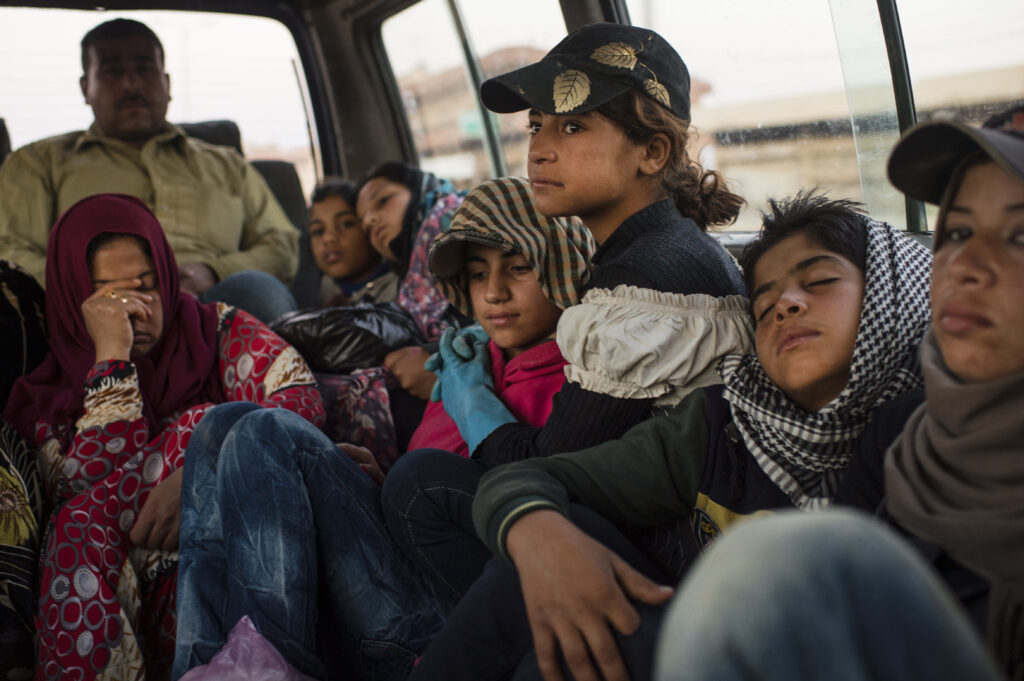Refugee children usually appear in the news media because they’ve died in a shocking accident, or they’re seen as a threat to the social order or the security of a nation where they’ve fled. In “The Displaced,” the New York Times Magazine’s look at child refugees, all three portraits of refugee children offer striking reminders of Kenyan poet Warsan Shire’s line that people only become refugees when home turns into “the mouth of a shark.” These intimate stories remind us that child refugees are just children, hopeful and resilient like my own, yet scarred by destruction and anguish.
The story of Hana is the main narrative, and it in particular resonates with me; I am the child of a refugee who fled with three little children (my siblings) from her house in Omwas, a small village near Jerusalem destroyed by the Israelis during the Six-Day War in 1967. My sister and I were born in Amman; it was home for us, but our mother was never liberated from the dream of going back to her house in Omwas. Reading Susan Dominus’ portrait of 12-year-old Hana, whose family fled Syria for southern Lebanon, I was brought back to the state of suspension we experienced through my mother, and reminded that the hope of returning home is the thread that allows refugees to maintain their dignity in an unwelcoming environment, even decades after hopes of a quick return disappear.
Dominus achieves a rare feat for a foreign journalist writing about Middle Eastern people. She shows us Hana as simply a girl, with no ideological baggage or oriental touches. Dominus skillfully uses pictorial language to make the reader feel near to Hana, both physically and emotionally. We see the girl
sleeping on her bamboo mat by the edge of her family’s tent, her arms folded, her hands under her head. Her baby brother and three of her four sisters sleep[ing] nearby.
Details of the humble life she has with her family are delivered in a considerate manner, alive with compassion and void of pity.
More Storyboard on “The Displaced”
The detailed narrative Dominus brings to the reader helps us develop familiarity with Hana’s place and time. It inspires warmth for her, as we witness “Hana’s first smile of the day.” Yet we also feel Hana’s pain and drained soul. The photos accompanying the piece underscore the word pictures, as when Hana rides a bus back from a long day picking crops in the fields of Lebanon’s Al Bekaa Valley.
This narrative speaks to the universal merit of journalistic works which help us not just be conscious of but cherish other humans. We dive with Dominus into Hana’s physical experience — “the almonds were stubborn, resisting her fingers” — and into her soul and consciousness.
Because of this careful reporting and stripped-away writing, Hana’s story lets 30 million other child refugees look us, the global reader, right in the eye, forcing us to see a far away and undesired reality from which we otherwise persistently detach ourselves. Hana’s story humanizes these millions of child refugees, through the techniques of naming, giving a face to these children, and the use of powerful visual representation.
This is a narrative of hardship in which physical destruction and psychological fatigue are omnipresent. Yet the story is woven with tiny threads of hope. Hana still dreams, wishing she could set a swing in the field of crops, and telling Dominus (and us) about her dream house. We see that Hana is still capable of love, as she holds her cousin tight on their way to their work at the farm. Through it all Dominus and the photographer, Lynsey Addario, make us aware of the otherness of Hana in her new surroundings, and remind us that hers is the experience of all refugees. The story brings to light an authentic refugee experience of longing, belonging and alienation, and we see the state of collective loneliness, hardship and disappointment imposed on them.

Hana’s story is part of a package of stories, photos and a virtual reality film. The film in particular has received extensive attention, and it does offer a remarkable way for us to see the multifaceted everyday lives of refugees. Yet Dominus’ story delivers at least as immersive a picture as the virtual reality film.
In the context of global discussion of the Syrian refugees crisis, this story is a treasured and truthful contribution to our understanding of the refugees’ dilemma. Dominus takes a crisis being told in statistics and gives it the necessary human element, allowing us to give them face, name and voice. I grew up in the Middle East, yes, but my family is free from strife. Hana was not, before this story, someone I would have felt I knew. Now I feel a considerable sense of identification with her. That is the sign of a fine narrative.
Abeer al-Najjar is associate professor of mass communication at the American University of Sharjah in the United Arab Emirates. She has a PhD in media and mass communications from the University of Edinburgh and spent 10 years as a journalist in the Middle East.


